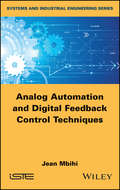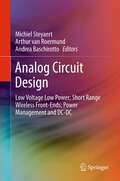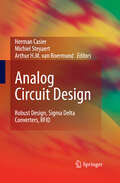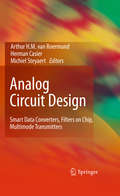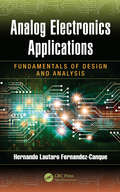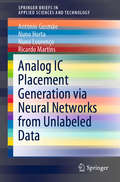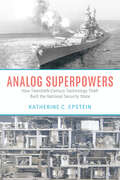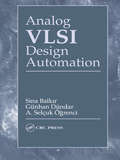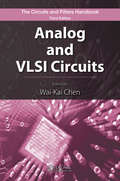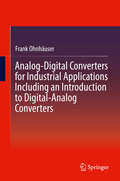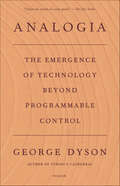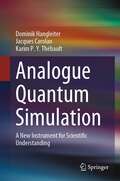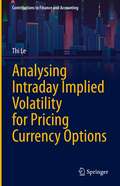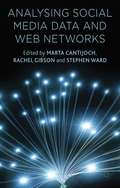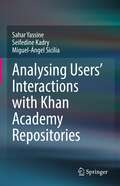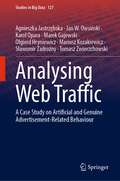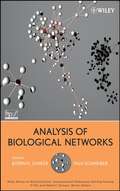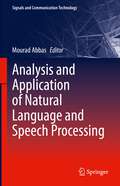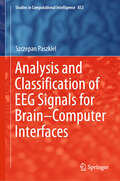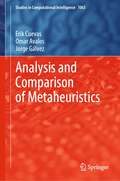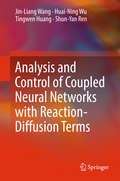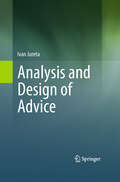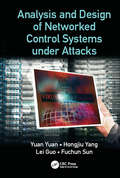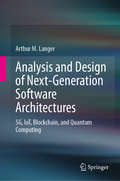- Table View
- List View
Analog Automation and Digital Feedback Control Techniques
by Jean MbihiThis book covers various modern theoretical, technical, practical and technological aspects of computerized numerical control and control systems of deterministic and stochastic dynamical processes.
Analog Circuit Design for Process Variation-Resilient Systems-on-a-Chip
by Marvin Onabajo Jose Silva-MartinezThis book describes several techniques to address variation-related design challenges for analog blocks in mixed-signal systems-on-chip. The methods presented are results from recent research works involving receiver front-end circuits, baseband filter linearization, and data conversion. These circuit-level techniques are described, with their relationships to emerging system-level calibration approaches, to tune the performances of analog circuits with digital assistance or control. Coverage also includes a strategy to utilize on-chip temperature sensors to measure the signal power and linearity characteristics of analog/RF circuits, as demonstrated by test chip measurements. Describes a variety of variation-tolerant analog circuit design examples, including from RF front-ends, high-performance ADCs and baseband filters;Includes built-in testing techniques, linked to current industrial trends;Balances digitally-assisted performance tuning with analog performance tuning and mismatch reduction approaches;Describes theoretical concepts as well as experimental results for test chips designed with variation-aware techniques.
Analog Circuit Design: Low Voltage Low Power; Short Range Wireless Front-Ends; Power Management and DC-DC
by Arthur Van Roermund Michiel Steyaert Andrea BaschirottoAnalog Circuit Design contains the contribution of 18 tutorials of the 20th workshop on Advances in Analog Circuit Design. Each part discusses a specific to-date topic on new and valuable design ideas in the area of analog circuit design. Each part is presented by six experts in that field and state of the art information is shared and overviewed. This book is number 20 in this successful series of Analog Circuit Design, providing valuable information and excellent overviews of: Topic 1 : Low Voltage Low Power, chairman: Andrea Baschirotto Topic 2 : Short Range Wireless Front-Ends, chairman: Arthur van Roermund Topic 3 : Power Management and DC-DC, chairman : Michiel Steyaert. Analog Circuit Design is an essential reference source for analog circuit designers and researchers wishing to keep abreast with the latest development in the field. The tutorial coverage also makes it suitable for use in an advanced design course.
Analog Circuit Design: Robust Design, Sigma Delta Converters, RFID (Analog Circuit Design Ser.)
by Michiel Steyaert Arthur H.M. van Roermund Herman CasierAnalog Circuit Design contains the contribution of 18 tutorials of the 19th workshop on Advances in Analog Circuit Design. Each part discusses a specific to-date topic on new and valuable design ideas in the area of analog circuit design. Each part is presented by six experts in that field and state of the art information is shared and overviewed. This book is number 20 in this successful series of Analog Circuit Design, providing valuable information and excellent overviews of: Robust Design, chaired by Herman Casier, ConsultantSigma Delta Converters, chaired by Prof. Michiel Steyaert, Catholic University LeuvenRFID, chaired by Prof. Arthur van Roermund, Eindhoven University of TechnologyAnalog Circuit Design is an essential reference source for analog circuit designers and researchers wishing to keep abreast with the latest development in the field. The tutorial coverage also makes it suitable for use in an advanced design course.
Analog Circuit Design: Smart Data Converters, Filters on Chip, Multimode Transmitters (Analog Circuit Design Ser.)
by Michiel Steyaert Arthur H.M. Roermund Herman CasierAnalog Circuit Design contains the contribution of 18 tutorials of the 18th workshop on Advances in Analog Circuit Design. Each part discusses a specific to-date topic on new and valuable design ideas in the area of analog circuit design. Each part is presented by six experts in that field and state of the art information is shared and overviewed. This book is number 18 in this successful series of Analog Circuit Design, providing valuable information and excellent overviews of: Smart Data Converters: Chaired by Prof. Arthur van Roermund, Eindhoven University of Technology, Filters on Chip: Chaired by Herman Casier, AMI Semiconductor Fellow, Multimode Transmitters: Chaired by Prof. M. Steyaert, Catholic University Leuven, Analog Circuit Design is an essential reference source for analog circuit designers and researchers wishing to keep abreast with the latest development in the field. The tutorial coverage also makes it suitable for use in an advanced design.
Analog Electronics Applications: Fundamentals of Design and Analysis
by Hernando Lautaro Fernandez-CanqueThis comprehensive text discusses the fundamentals of analog electronics applications, design, and analysis. Unlike the physics approach in other analog electronics books, this text focuses on an engineering approach, from the main components of an analog circuit to general analog networks. Concentrating on development of standard formulae for conventional analog systems, the book is filled with practical examples and detailed explanations of procedures to analyze analog circuits. The book covers amplifiers, filters, and op-amps as well as general applications of analog design.
Analog IC Placement Generation via Neural Networks from Unlabeled Data (SpringerBriefs in Applied Sciences and Technology)
by Nuno Horta Nuno Lourenço Ricardo Martins António GusmãoIn this book, innovative research using artificial neural networks (ANNs) is conducted to automate the placement task in analog integrated circuit layout design, by creating a generalized model that can generate valid layouts at push-button speed. Further, it exploits ANNs’ generalization and push-button speed prediction (once fully trained) capabilities, and details the optimal description of the input/output data relation. The description developed here is chiefly reflected in two of the system’s characteristics: the shape of the input data and the minimized loss function. In order to address the latter, abstract and segmented descriptions of both the input data and the objective behavior are developed, which allow the model to identify, in newer scenarios, sub-blocks which can be found in the input data. This approach yields device-level descriptions of the input topology that, for each device, focus on describing its relation to every other device in the topology. By means of these descriptions, an unfamiliar overall topology can be broken down into devices that are subject to the same constraints as a device in one of the training topologies. In the experimental results chapter, the trained ANNs are used to produce a variety of valid placement solutions even beyond the scope of the training/validation sets, demonstrating the model’s effectiveness in terms of identifying common components between newer topologies and reutilizing the acquired knowledge. Lastly, the methodology used can readily adapt to the given problem’s context (high label production cost), resulting in an efficient, inexpensive and fast model.
Analog Superpowers: How Twentieth-Century Technology Theft Built the National Security State
by Katherine C. EpsteinA gripping history that spans law, international affairs, and top-secret technology to unmask the tension between intellectual property rights and national security. At the beginning of the twentieth century, two British inventors, Arthur Pollen and Harold Isherwood, became fascinated by a major military question: how to aim the big guns of battleships. These warships—of enormous geopolitical import before the advent of intercontinental missiles or drones—had to shoot in poor light and choppy seas at distant moving targets, conditions that impeded accurate gunfire. Seeing the need to account for a plethora of variables, Pollen and Isherwood built an integrated system for gathering data, calculating predictions, and transmitting the results to the gunners. At the heart of their invention was the most advanced analog computer of the day, a technological breakthrough that anticipated the famous Norden bombsight of World War II, the inertial guidance systems of nuclear missiles, and the networked “smart” systems that dominate combat today. Recognizing the value of Pollen and Isherwood’s invention, the British Royal Navy and the United States Navy pirated it, one after the other. When the inventors sued, both the British and US governments invoked secrecy, citing national security concerns. Drawing on a wealth of archival evidence, Analog Superpowers analyzes these and related legal battles over naval technology, exploring how national defense tested the two countries’ commitment to individual rights and the free market. Katherine C. Epstein deftly sets out Pollen’s and Isherwood’s pioneering achievements, the patent questions raised, the geopolitical rivalry between Britain and the United States, and the legal precedents each country developed to control military tools built by private contractors. Epstein’s account reveals that long before the US national security state sought to restrict information about atomic energy, it was already embroiled in another contest between innovation and secrecy. The America portrayed in this sweeping and accessible history isn’t yet a global hegemon but a rising superpower ready to acquire foreign technology by fair means or foul—much as it accuses China of doing today.
Analog VLSI Design Automation (Vlsi Circuits Ser.)
by Sina Balkir Günhan Dündar A. Selçuk ÖgrenciThe explosive growth and development of the integrated circuit market over the last few years have been mostly limited to the digital VLSI domain. The difficulty of automating the design process in the analog domain, the fact that a general analog design methodology remained undefined, and the poor performance of earlier tools have left the analog
Analog and VLSI Circuits (The Circuits and Filters Handbook, 3rd Edition)
by Wai-Kai ChenFeaturing hundreds of illustrations and references, this volume in the third edition of the Circuits and Filters Handbook, provides the latest information on analog and VLSI circuits, omitting extensive theory and proofs in favor of numerous examples throughout each chapter. The first part of the text focuses on analog integrated circuits, presenting up-to-date knowledge on monolithic device models, analog circuit cells, high performance analog circuits, RF communication circuits, and PLL circuits. In the second half of the book, well-known contributors offer the latest findings on VLSI circuits, including digital systems, data converters, and systolic arrays.
Analog-Digital Converters for Industrial Applications Including an Introduction to Digital-Analog Converters
by Frank OhnhäuserThis book offers students and those new to the topic of analog-to-digital converters (ADCs) a broad introduction, before going into details of the state-of-the-art design techniques for SAR and DS converters, including the latest research topics, which are valuable for IC design engineers as well as users of ADCs in applications. The book then addresses important topics, such as correct connectivity of ADCs in an application, the verification, characterization and testing of ADCs that ensure high-quality end products. Analog-to-digital converters are the central element in any data processing system and regulation loops such as modems or electrical motor drives. They significantly affect the performance and resolution of a system or end product. System development engineers need to be familiar with the performance parameters of the converters and understand the advantages and disadvantages of the various architectures. Integrated circuit development engineers have to overcome the problem of achieving high performance and resolution with the lowest possible power dissipation, while the digital circuitry generates distortion in supply, ground and substrate. This book explains the connections and gives suggestions for obtaining the highest possible resolution. Novel trends are illustrated in the design of analog-to-digital converters based on successive approximation and the difficulties in the development of continuous-time delta-sigma modulators are also discussed.
Analogia: The Emergence of Technology Beyond Programmable Control
by George DysonNamed one of WIRED’s "The Best Pop Culture That Got Us Through 2020"In Analogia, technology historian George Dyson presents a startling look back at the analog age and life before the digital revolution—and an unsettling vision of what comes next.In 1716, the philosopher and mathematician Gottfried Wilhelm Leibniz spent eight days taking the cure with Peter the Great at Bad Pyrmont in Saxony, trying to persuade the tsar to launch a voyage of discovery from Russia to America and to adopt digital computing as the foundation for a remaking of life on earth. In two classic books, Darwin Among the Machines and Turing’s Cathedral, George Dyson chronicled the realization of the second of Leibniz’s visions. In Analogia, his pathbreaking new book, he brings the story full circle, starting with the Russian American expedition of 1741 and ending with the beyond-digital revolution that will completethe transformation of the world.Dyson enlists a startling cast of characters, from the time of Catherine the Great to the age of machine intelligence, and draws heavily on his own experiences at the Institute for Advanced Study in Princeton, New Jersey, and onward to the rain forest of the Northwest Coast. We are, Dyson reveals, entering a new epoch in human history, one driven by a generation of machines whose powers are no longer under programmable control. Includes black-and-white illustrations
Analogue Quantum Simulation: A New Instrument for Scientific Understanding
by Dominik Hangleiter Jacques Carolan Karim P. ThébaultThis book presents fresh insights into analogue quantum simulation. It argues that these simulations are a new instrument of science. They require a bespoke philosophical analysis, sensitive to both the similarities to and the differences with conventional scientific practices such as analogical argument, experimentation, and classical simulation.The analysis situates the various forms of analogue quantum simulation on the methodological map of modern science. In doing so, it clarifies the functions that analogue quantum simulation serves in scientific practice. To this end, the authors introduce a number of important terminological distinctions. They establish that analogue quantum ‘computation' and ‘emulation' are distinct scientific practices and lead to distinct forms of scientific understanding. The authors also demonstrate the normative value of the computation vs. emulation distinction at both an epistemic and a pragmatic level.The volume features a range of detailed case studies focusing on: i) cold atom computation of many-body localisation and the Higgs mode; ii) photonic emulation of quantum effects in biological systems; and iii) emulation of Hawing radiation in dispersive optical media. Overall, readers will discover a normative framework to isolate and support the goals of scientists undertaking analogue quantum simulation and emulation. This framework will prove useful to both working scientists and philosophers of science interested in cutting-edge scientific practice.
Analysing Intraday Implied Volatility for Pricing Currency Options (Contributions to Finance and Accounting)
by Thi LeThis book focuses on the impact of high-frequency data in forecasting market volatility and options price. New technologies have created opportunities to obtain better, faster, and more efficient datasets to explore financial market phenomena at the most acceptable data levels. It provides reliable intraday data supporting financial investment decisions across different assets classes and instruments consisting of commodities, derivatives, equities, fixed income and foreign exchange. This book emphasises four key areas, (1) estimating intraday implied volatility using ultra-high frequency (5-minutes frequency) currency options to capture traders' trading behaviour, (2) computing realised volatility based on 5-minute frequency currency price to obtain speculators' speculation attitude, (3) examining the ability of implied volatility to subsume market information through forecasting realised volatility and (4) evaluating the predictive power of implied volatility for pricing currency options. This is a must-read for academics and professionals who want to improve their skills and outcomes in trading options.
Analysing Social Media Data and Web Networks
by Rachel Gibson Stephen Ward Marta CantijochAs governments, citizens and organizations have moved online there is an increasing need for academic enquiry to adapt to this new context for communication and political action. This adaptation is crucially dependent on researchers being equipped with the necessary methodological tools to extract, analyze and visualize patterns of web activity. This volume profiles the latest techniques being employed by social scientists to collect and interpret data from some of the most popular social media applications, the political parties' own online activist spaces, and the wider system of hyperlinks that structure the inter-connections between these sites. Including contributions from a range of academic disciplines including Political Science, Media and Communication Studies, Economics, and Computer Science, this study showcases a new methodological approach that has been expressly designed to capture and analyze web data in the process of investigating substantive questions.
Analysing Users' Interactions with Khan Academy Repositories
by Seifedine Kadry Sahar Yassine Miguel-Ángel SiciliaThis book addresses the need to explore user interaction with online learning repositories and the detection of emergent communities of users. This is done through investigating and mining the Khan Academy repository; a free, open access, popular online learning repository addressing a wide content scope. It includes large numbers of different learning objects such as instructional videos, articles, and exercises. The authors conducted descriptive analysis to investigate the learning repository and its core features such as growth rate, popularity, and geographical distribution. The authors then analyzed this graph and explored the social network structure, studied two different community detection algorithms to identify the learning interactions communities emerged in Khan Academy then compared between their effectiveness. They then applied different SNA measures including modularity, density, clustering coefficients and different centrality measures to assess the users’ behavior patterns and their presence.By applying community detection techniques and social network analysis, the authors managed to identify learning communities in Khan Academy’s network. The size distribution of those communities found to follow the power-law distribution which is the case of many real-world networks.Despite the popularity of online learning repositories and their wide use, the structure of the emerged learning communities and their social networks remain largely unexplored. This book could be considered initial insights that may help researchers and educators in better understanding online learning repositories, the learning process inside those repositories, and learner behavior.
Analysing Web Traffic: A Case Study on Artificial and Genuine Advertisement-Related Behaviour (Studies in Big Data #127)
by Sławomir Zadrożny Jan W. Owsiński Olgierd Hryniewicz Karol Opara Agnieszka Jastrzębska Marek Gajewski Mariusz Kozakiewicz Tomasz ZwierzchowskiThis book presents ample, richly illustrated account on results and experience from a project, dealing with the analysis of data concerning behavior patterns on the Web. The advertising on the Web is dealt with, and the ultimate issue is to assess the share of the artificial, automated activity (ads fraud), as opposed to the genuine human activity.After a comprehensive introductory part, a full-fledged report is provided from a wide range of analytic and design efforts, oriented at: the representation of the Web behavior patterns, formation and selection of telling variables, structuring of the populations of behavior patterns, including the use of clustering, classification of these patterns, and devising most effective and efficient techniques to separate the artificial from the genuine traffic.A series of important and useful conclusions is drawn, concerning both the nature of the observed phenomenon, and hence the characteristics of the respective datasets, and the appropriateness of the methodological approaches tried out and devised. Some of these observations and conclusions, both related to data and to methods employed, provide a new insight and are sometimes surprising. The book provides also a rich bibliography on the main problem approached and on the various methodologies tried out.
Analysis Of Biological Networks
by Falk Schreiber Björn H. JunkerAn introduction to biological networks and methods for their analysis Analysis of Biological Networks is the first book of its kind to provide readers with a comprehensive introduction to the structural analysis of biological networks at the interface of biology and computer science. The book begins with a brief overview of biological networks and graph theory/graph algorithms and goes on to explore: global network properties, network centralities, network motifs, network clustering, Petri nets, signal transduction and gene regulation networks, protein interaction networks, metabolic networks, phylogenetic networks, ecological networks, and correlation networks. Analysis of Biological Networks is a self-contained introduction to this important research topic, assumes no expert knowledge in computer science or biology, and is accessible to professionals and students alike. Each chapter concludes with a summary of main points and with exercises for readers to test their understanding of the material presented. Additionally, an FTP site with links to author-provided data for the book is available for deeper study. This book is suitable as a resource for researchers in computer science, biology, bioinformatics, advanced biochemistry, and the life sciences, and also serves as an ideal reference text for graduate-level courses in bioinformatics and biological research.
Analysis and Application of Natural Language and Speech Processing (Signals and Communication Technology)
by Mourad AbbasThis book presents recent advances in NLP and speech technology, a topic attracting increasing interest in a variety of fields through its myriad applications, such as the demand for speech guided touchless technology during the Covid-19 pandemic. The authors present results of recent experimental research that provides contributions and solutions to different issues related to speech technology and speech in industry. Technologies include natural language processing, automatic speech recognition (for under-resourced dialects) and speech synthesis that are useful for applications such as intelligent virtual assistants, among others. Applications cover areas such as sentiment analysis and opinion mining, Arabic named entity recognition, and language modelling. This book is relevant for anyone interested in the latest in language and speech technology.
Analysis and Classification of EEG Signals for Brain–Computer Interfaces (Studies in Computational Intelligence #852)
by Szczepan PaszkielThis book addresses the problem of EEG signal analysis and the need to classify it for practical use in many sample implementations of brain–computer interfaces. In addition, it offers a wealth of information, ranging from the description of data acquisition methods in the field of human brain work, to the use of Moore–Penrose pseudo inversion to reconstruct the EEG signal and the LORETA method to locate sources of EEG signal generation for the needs of BCI technology. In turn, the book explores the use of neural networks for the classification of changes in the EEG signal based on facial expressions. Further topics touch on machine learning, deep learning, and neural networks. The book also includes dedicated implementation chapters on the use of brain–computer technology in the field of mobile robot control based on Python and the LabVIEW environment. In closing, it discusses the problem of the correlation between brain–computer technology and virtual reality technology.
Analysis and Comparison of Metaheuristics (Studies in Computational Intelligence #1063)
by Erik Cuevas Jorge Gálvez Omar AvalosThis book presents a comparative perspective of current metaheuristic developments, which have proved to be effective in their application to several complex problems. The study of biological and social entities such as animals, humans, or insects that manifest a cooperative behavior has produced several computational models in metaheuristic methods. Although these schemes emulate very different processes or systems, the rules used to model individual behavior are very similar. Under such conditions, it is not clear to identify which are the advantages or disadvantages of each metaheuristic technique. The book is compiled from a teaching perspective. For this reason, the book is primarily intended for undergraduate and postgraduate students of Science, Electrical Engineering, or Computational Mathematics. It is appropriate for courses such as Artificial Intelligence, Electrical Engineering, Evolutionary Computation. The book is also useful for researchers from the evolutionary and engineering communities. Likewise, engineer practitioners, who are not familiar with metaheuristic computation concepts, will appreciate that the techniques discussed are beyond simple theoretical tools since they have been adapted to solve significant problems that commonly arise in engineering areas.
Analysis and Control of Coupled Neural Networks with Reaction-Diffusion Terms
by Tingwen Huang Jin-Liang Wang Huai-Ning Wu Shun-Yan RenThis book introduces selected recent findings on the analysis and control of dynamical behaviors for coupled reaction-diffusion neural networks. It presents novel research ideas and essential definitions concerning coupled reaction-diffusion neural networks, such as passivity, adaptive coupling, spatial diffusion coupling, and the relationship between synchronization and output strict passivity. Further, it gathers research results previously published in many flagship journals, presenting them in a unified form. As such, the book will be of interest to all university researchers and graduate students in Engineering and Mathematics who wish to study the dynamical behaviors of coupled reaction-diffusion neural networks.
Analysis and Design of Advice
by Ivan JuretaThis innovative book offers a rigorous approach to the analysis and design of advice in real-world decision situations, in which the advisor must manage with variously imprecise, unclear, incomplete or conflicting qualitative information.
Analysis and Design of Networked Control Systems under Attacks
by Fuchun Sun Yuan Yuan Hongjiu Yang Lei GuoThis book adopts a systematic view of the control systems in cyber-physical systems including the security control of the optimal control system, security control of the non-cooperative game system, quantify the impact of the Denial-of-Service attacks on the optimal control system, and the adaptive security control of the networked control systems. Because the cyber-physical system is a hybrid system, it adopts cross layer approach to handle the security control of the CPS. It presents a number of attack models according to the attack scenario and defense facilities, and a number of cross-layer co-design methodologies to secure the control of CPS.
Analysis and Design of Next-Generation Software Architectures: 5G, IoT, Blockchain, and Quantum Computing
by Arthur M. LangerThis book provides a detailed “how-to” guide, addressing aspects ranging from analysis and design to the implementation of applications, which need to be integrated within legacy applications and databases.The analysis and design of the next generation of software architectures must address the new requirements to accommodate the Internet of things (IoT), cybersecurity, blockchain networks, cloud, and quantum computer technologies. As 5G wireless increasingly establishes itself over the next few years, moving legacy applications into these new architectures will be critical for companies to compete in a consumer-driven and social media-based economy. Few organizations, however, understand the challenges and complexities of moving from a central database legacy architecture to a ledger and networked environment.The challenge is not limited to just designing new software applications. Indeed, the next generation needs to function more independently on various devices, and on more diverse and wireless-centric networks. Furthermore, databases must be broken down into linked list-based blockchain architectures, which will involve analytic decisions regarding which portions of data and metadata will be processed within the chain, and which ones will be dependent on cloud systems. Finally, the collection of all data throughout these vast networks will need to be aggregated and used for predictive analysis across a variety of competitive business applications in a secured environment. Certainly not an easy task for any analyst/designer!Many organizations will continue to use packaged products and open-source applications. These third-party products will need to be integrated into the new architecture paradigms and have seamless data aggregation capabilities, while maintaining the necessary cyber compliances. The book also clearly defines the roles and responsibilities of the stakeholders involved, including the IT departments, users, executive sponsors, and third-party vendors. The book’s structure also provides a step-by-step method to help ensure a higher rate of success in the context of re-engineering existing applications and databases, as well as selecting third-party products, conversion methods and cybercontrols. It was written for use by a broad audience, including IT developers, software engineers, application vendors, business line managers, and executives.
